New Zealand Self-Monitoring Blood Glucose Market Size
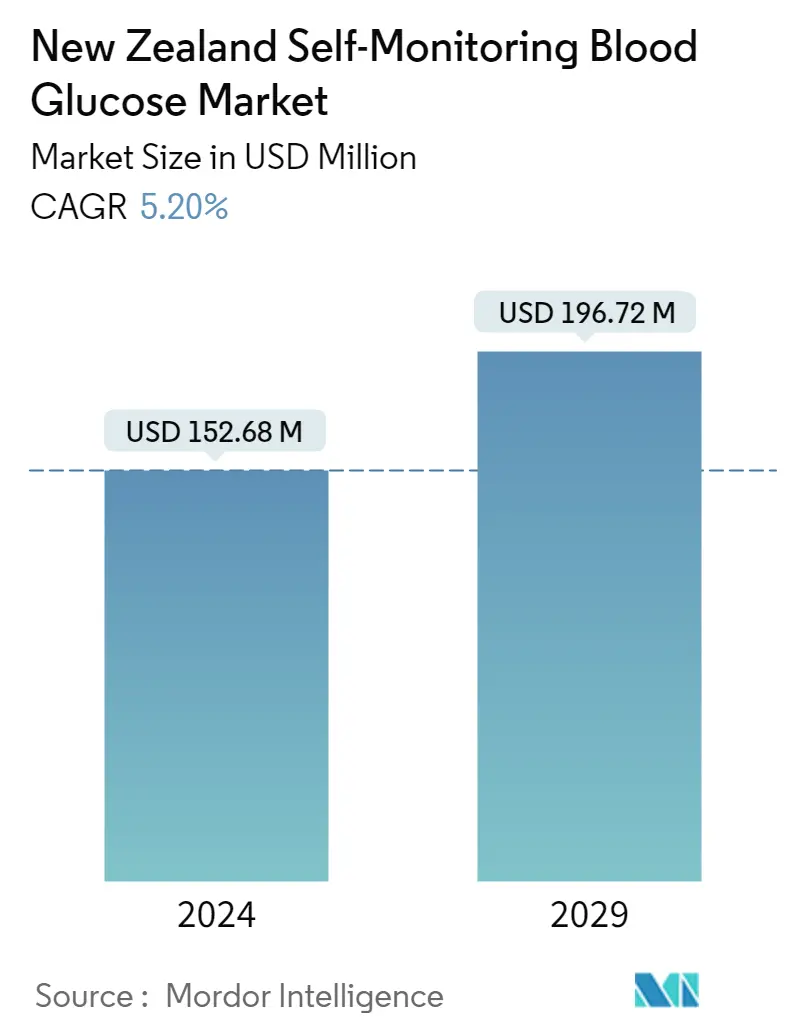
| Study Period | 2019 - 2029 |
| Base Year For Estimation | 2023 |
| Forecast Data Period | 2024 - 2029 |
| Market Size (2024) | USD 152.68 Million |
| Market Size (2029) | USD 196.72 Million |
| CAGR (2024 - 2029) | 5.20 % |
Major Players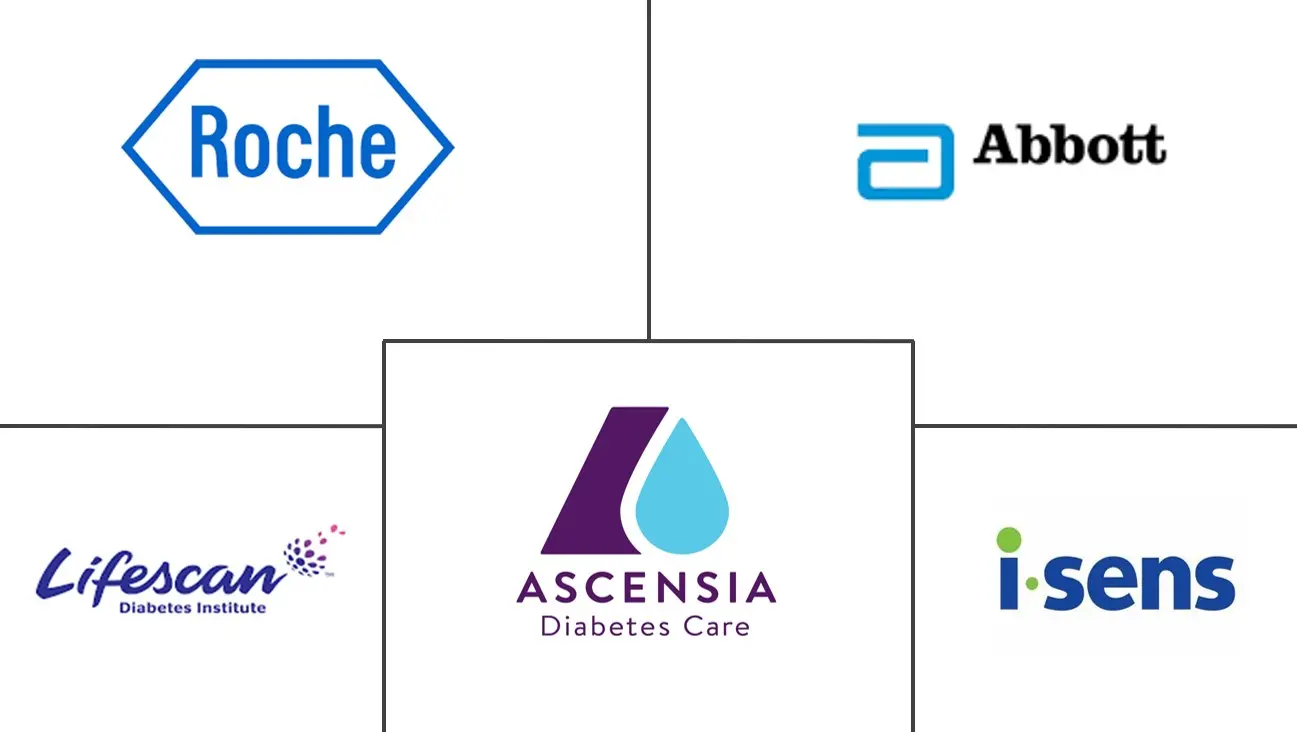
*Disclaimer: Major Players sorted in no particular order |
New Zealand Self-Monitoring Blood Glucose Market Analysis
The New Zealand Self-Monitoring Blood Glucose Market size is estimated at USD 152.68 million in 2024, and is expected to reach USD 196.72 million by 2029, growing at a CAGR of 5.20% during the forecast period (2024-2029).
The COVID-19 pandemic showed that diabetes needs a lot more attention if we don't want the infection to cause problems that aren't necessary or fair.All the steps needed to protect this high-risk group were taken and kept up. For example, there were national public health measures to stop the spread of the disease, vaccinations were given, and workplace risk assessments were done.Additionally, it was crucial to guarantee that people with diabetes continue to receive regular evaluations from their primary care or diabetes-specific healthcare providers.For people who were in the hospital, it was important to get good glycemic control and aim for blood glucose levels between 4 and 10 mmol/L. If possible, diabetes specialist teams should be brought in early to prevent bad outcomes.
When a person with diabetes has high blood glucose levels that don't go down, it can cause damage to the kidneys, nerves, and eyes. Blood glucose measurement helps figure out how well blood glucose is being used by the body and shows how to get the best glucose control in the body. Over time, the readings give the patient and their doctors the information they need to figure out the best way to treat diabetes.When blood glucose levels are too high or too low, they can be managed successfully, which keeps health problems related to diabetes to a minimum.
Technology improvements in blood glucose meters, like ones that connect to cellular networks and automatically upload SMBG data to secure cloud-based databases, make it easier to share and track SMBG data. Real-time monitoring of SMBG data gives doctors the chance to help patients who respond to abnormal SMBG recordings right away. Such benefits can give people with T2D that aren't well controlled the extra help they need to improve critical outcomes, which will improve the market's chances in the years to come.
New Zealand Self-Monitoring Blood Glucose Market Trends
Rising Diabetes Prevalence in New Zealand
During the forecast period, there is likely to be a big increase in the number of people with diabetes in New Zealand. By 2028, about 360,000 people are expected to have diabetes.
There is a double burden because Mori and Pasifika have higher rates and worse outcomes, and they also usually have more social and economic problems. Type 1 diabetes is strongly linked to a family history of the condition, but the exact cause is unknown. No changeable factors make it more likely to get type 1 diabetes, but living a healthy life is important for dealing with the symptoms and long-term problems that come with it. People are at a higher risk of getting type 2 diabetes. Major biomedical risk factors for type 2 diabetes are impaired fasting glucose and impaired glucose tolerance, high blood pressure, dyslipidemia, overweight and abdominal obesity, and behavioral risk factors including unhealthy diets, insufficient physical activity, and smoking.
According to the New Zealand Health Survey by the Ministry of Health, the prevalence of obesity in New Zealand adults was around 34% in 2021/22. Diabetes can lead to a lot of different problems, such as a stroke, kidney disease, nerve damage, hearing loss, high blood pressure, problems with the eyes, feet, skin, etc.Because of this, people with diabetes need to have their blood sugar levels checked all the time.The first step in treating diabetes is to lower blood sugar. People with diabetes need to be watched to make sure their blood sugar levels don't go above the normal range.
Self-monitoring is a commitment that many diabetic patients follow to manage their condition. The blood glucose levels help the patients and doctors modify their diet, lifestyle, insulin therapy, and medications to help their blood sugar return to normal. With newer innovations in medical technology, glucometers these days have highly sensitive strips and sensors that can detect every component of blood accurately, close to lab results.
Thus, the studied market is likely to grow during the analysis period because of the factors listed above and the rise in popularity.
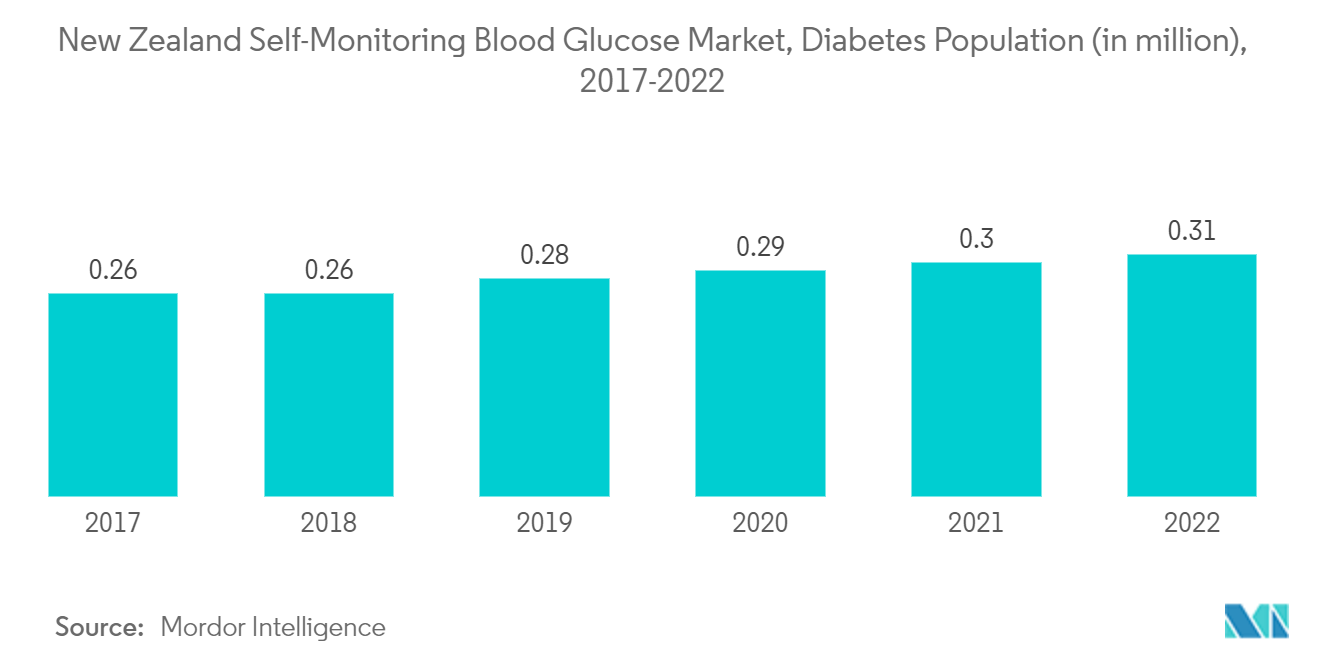
The Test Strips Segment held the highest market share in the current year
The Test Strips Segment recorded a market share of about 70% in the current year.
Blood glucose test strips are small, disposable strips that are a key component of blood glucose testing. When blood is placed on the test strip, it reacts with a chemical called glucose oxidase, producing gluconic acid from the glucose in the blood. At the other end of the test strip, the meter transfers a current to the test strip. The test strip has electric terminals, which allow the meter to measure the current between the terminals. How much gluconic acid has been made affects the flow of electricity between the terminals.The blood glucose meter then uses an algorithm to work out the blood glucose level based on the difference in current.
The growth in market share of test strips is expected to be higher than that of glucose meters because of the difference in use-case frequency. The glucometer is a one-time purchase, but test strips are an ongoing cost because they need to be thrown away after each use.A typical glucose meter will last between six months and three years and will only cost you once during that time.
PHARMAC is the government agency that decides which medicines and related products are funded in Aotearoa New Zealand. PHARMAC funds CareSens N and CareSens PRO blood glucose test strips; SensoCard blood glucose test strips (for patients who are visually impaired); CareSens N, CareSens N POP, and CareSens N Premier blood glucose diagnostic test meters; the CareSens Dual blood glucose and blood ketone diagnostic test meter; and KetoSens blood ketone diagnostic test strips. Such initiatives are expected to drive the market over the forecast period.
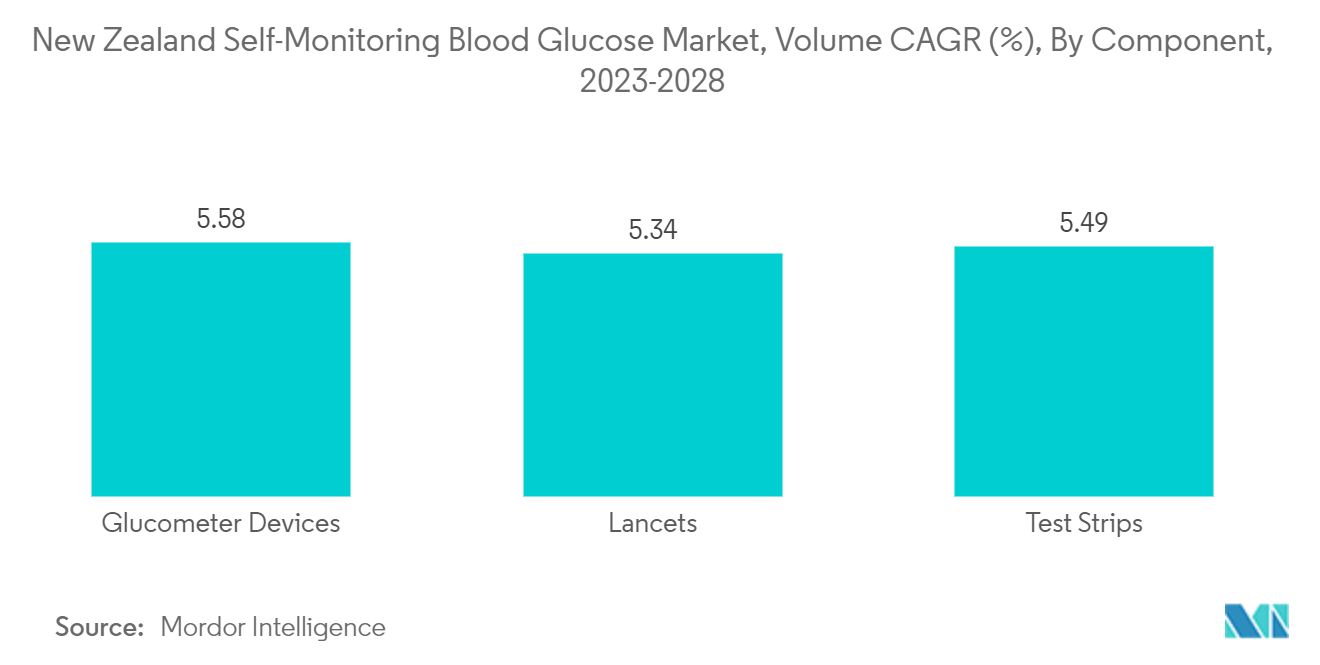
New Zealand Self-Monitoring Blood Glucose Industry Overview
New Zealand self-monitoring blood glucose market is moderately fragmented, with a few significant and other generic players. Manufacturers like i-Sens, Abbott, LifeScan, and Ascensia occupy a major share.
New Zealand Self-Monitoring Blood Glucose Market Leaders
-
Abbott Diabetes Care
-
Roche Diabetes Care
-
LifeScan Inc.
-
Ascensia Diabetes Care
-
i-SENS, Inc.
*Disclaimer: Major Players sorted in no particular order
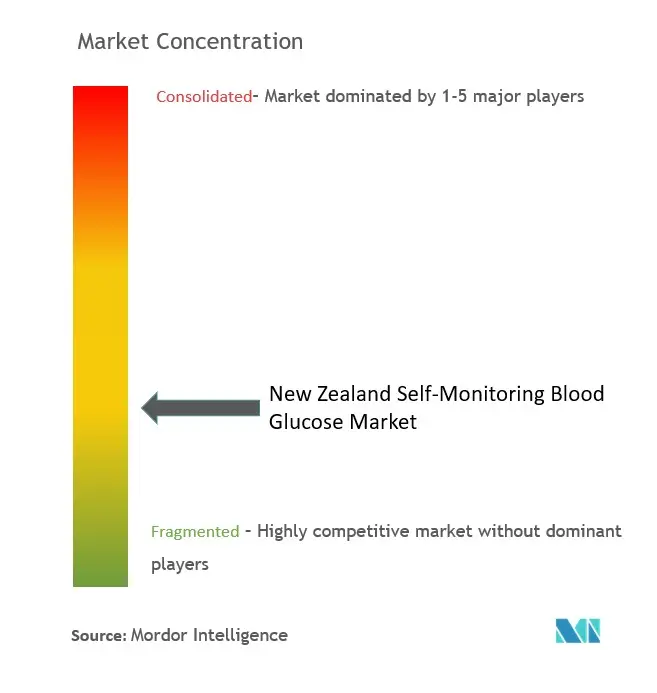
New Zealand Self-Monitoring Blood Glucose Market News
- January, 2023: LifeScan announced that the peer-reviewed Journal of Diabetes Science and Technology published Improved Glycemic Control Using a Bluetooth Connected Blood Glucose Meter and a Mobile Diabetes App: Real-World Evidence From Over 144,000 People With Diabetes, detailing results from a retrospective analysis of real-world data from over 144,000 people with diabetes-one of the largest combined blood glucose meter and mobile diabetes app datasets ever published.
- January 20, 2022: Roche launched its new point-of-care blood glucose monitor designed for hospital professionals with a companion device shaped like a touchscreen smartphone that will run its own apps. The hand-held COBAS Pulse includes an automated glucose test strip reader as well as a camera and touchscreen for logging other diagnostic results. It's designed to be used with patients of all ages, including neonates and people in intensive care.
New Zealand Self-Monitoring Blood Glucose Market Report - Table of Contents
1. INTRODUCTION
- 1.1 Study Assumptions and Market Definition
- 1.2 Scope of the Study
2. RESEARCH METHODOLOGY
3. EXECUTIVE SUMMARY
4. MARKET DYNAMICS
- 4.1 Market Overview
- 4.2 Market Drivers
- 4.3 Market Restraints
-
4.4 Porter's Five Forces Analysis
- 4.4.1 Bargaining Power of Suppliers
- 4.4.2 Bargaining Power of Consumers
- 4.4.3 Threat of New Entrants
- 4.4.4 Threat of Substitute Products and Services
- 4.4.5 Intensity of Competitive Rivalry
5. MARKET SEGMENTATION
-
5.1 Component (Value and Volume, 2017 - 2028)
- 5.1.1 Glucometer Devices
- 5.1.2 Test Strips
- 5.1.3 Lancets
6. MARKET INDICATORS
- 6.1 Type-1 Diabetes population (2017 - 2028)
- 6.2 Type-2 Diabetes population (2017 - 2028)
7. COMPETITIVE LANDSCAPE
-
7.1 COMPANY PROFILES
- 7.1.1 Abbott Diabetes Care
- 7.1.2 Roche Holding AG
- 7.1.3 LifeScan
- 7.1.4 Trividia Health
- 7.1.5 Ascensia Diabetes Care
- 7.1.6 Acon Laboratories Inc.
- 7.1.7 Agamatrix Inc.
- 7.1.8 Bionime Corporation
- 7.1.9 i-Sens
- 7.1.10 Arkray Inc.
- *List Not Exhaustive
-
7.2 COMPANY SHARE ANALYSIS
- 7.2.1 Abbott Diabetes Care
- 7.2.2 Roche Holding AG
- 7.2.3 LifeScan
- 7.2.4 Others
8. MARKET OPPORTUNITIES AND FUTURE TRENDS
** Subject To AvailablityNew Zealand Self-Monitoring Blood Glucose Industry Segmentation
Diabetic patients can measure their own blood sugar levels using a glucometer, test strips, and lancets by self-monitoring their blood glucose. Based on the readings, patients can adjust or check the effect of their treatment. The New Zealand market for self-monitoring blood glucose is segmented into components (glucometer devices, test strips, and lancets). The report offers the value (in USD million) and volume (in million units) for the above segments.
| Component (Value and Volume, 2017 - 2028) | Glucometer Devices |
| Test Strips | |
| Lancets |
New Zealand Self-Monitoring Blood Glucose Market Research FAQs
How big is the New Zealand Self-Monitoring Blood Glucose Market?
The New Zealand Self-Monitoring Blood Glucose Market size is expected to reach USD 152.68 million in 2024 and grow at a CAGR of 5.20% to reach USD 196.72 million by 2029.
What is the current New Zealand Self-Monitoring Blood Glucose Market size?
In 2024, the New Zealand Self-Monitoring Blood Glucose Market size is expected to reach USD 152.68 million.
Who are the key players in New Zealand Self-Monitoring Blood Glucose Market?
Abbott Diabetes Care, Roche Diabetes Care, LifeScan Inc., Ascensia Diabetes Care and i-SENS, Inc. are the major companies operating in the New Zealand Self-Monitoring Blood Glucose Market.
What years does this New Zealand Self-Monitoring Blood Glucose Market cover, and what was the market size in 2023?
In 2023, the New Zealand Self-Monitoring Blood Glucose Market size was estimated at USD 145.13 million. The report covers the New Zealand Self-Monitoring Blood Glucose Market historical market size for years: 2019, 2020, 2021, 2022 and 2023. The report also forecasts the New Zealand Self-Monitoring Blood Glucose Market size for years: 2024, 2025, 2026, 2027, 2028 and 2029.
New Zealand Self-Monitoring Blood Glucose Industry Report
Statistics for the 2024 New Zealand Self-Monitoring Blood Glucose market share, size and revenue growth rate, created by Mordor Intelligence™ Industry Reports. New Zealand Self-Monitoring Blood Glucose analysis includes a market forecast outlook to 2029 and historical overview. Get a sample of this industry analysis as a free report PDF download.



